Comprehensive Personality Profile Report: HPS307 Inventory Comparison
VerifiedAdded on 2023/06/05
|8
|2069
|327
Report
AI Summary
This report provides a detailed analysis of a personality profile based on three inventories: IPIP, HEXACO, and BFI-10. It interprets the personality profile using factors and facets from each inventory, comparing the results across the three assessments and identifying similarities and differences. The report discusses the accuracy of each profile, potential reasons for discrepancies (including test-taker state of mind and inventory design), and compares the predicted profile with the actual profiles. It also addresses the question of whether the profile provides enough information to describe the personality and whether it would be appropriate for clinical or employment decisions. The analysis considers the impact of external factors, emotional states, and the potential for individuals to present differently in formal settings.
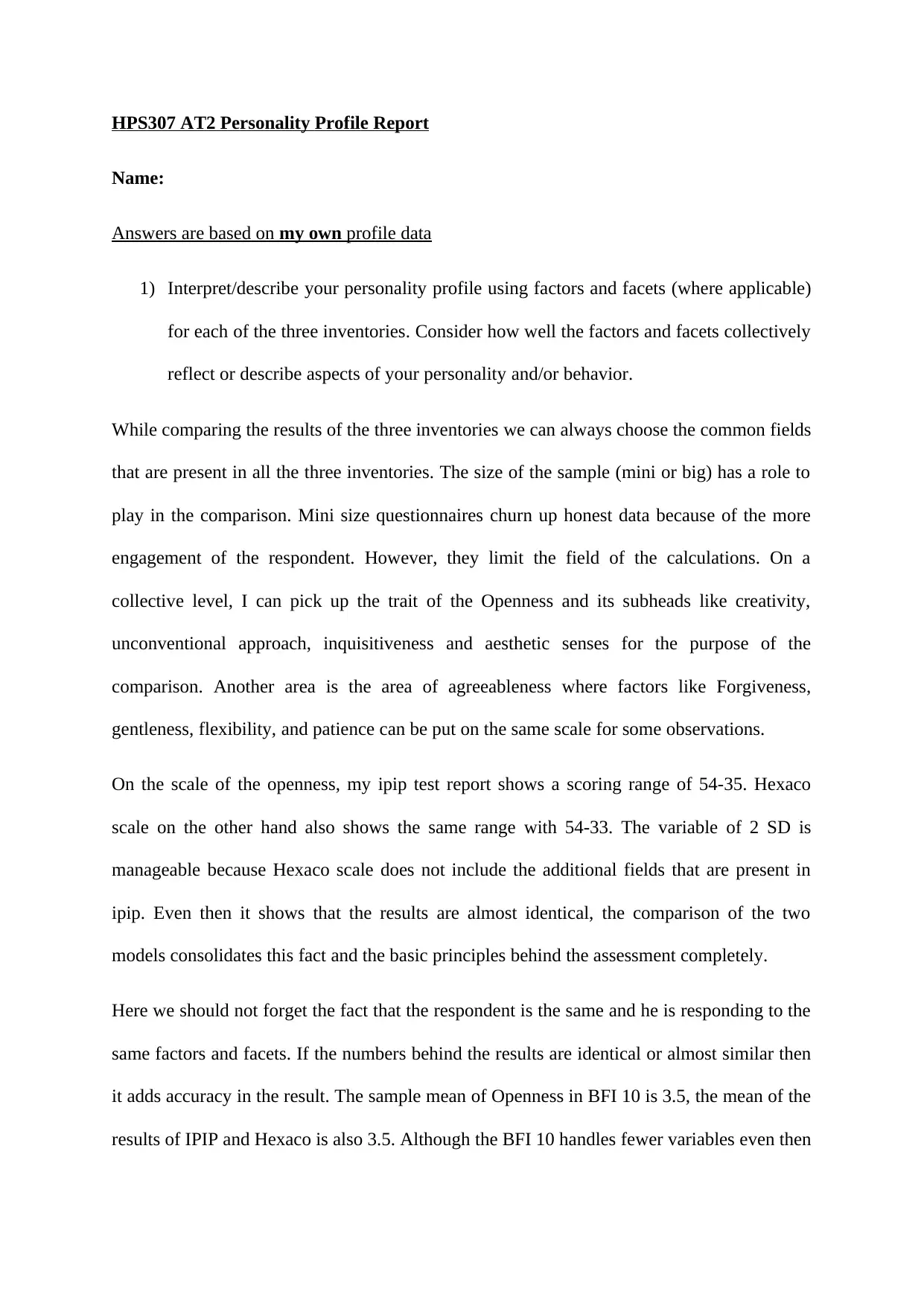
HPS307 AT2 Personality Profile Report
Name:
Answers are based on my own profile data
1) Interpret/describe your personality profile using factors and facets (where applicable)
for each of the three inventories. Consider how well the factors and facets collectively
reflect or describe aspects of your personality and/or behavior.
While comparing the results of the three inventories we can always choose the common fields
that are present in all the three inventories. The size of the sample (mini or big) has a role to
play in the comparison. Mini size questionnaires churn up honest data because of the more
engagement of the respondent. However, they limit the field of the calculations. On a
collective level, I can pick up the trait of the Openness and its subheads like creativity,
unconventional approach, inquisitiveness and aesthetic senses for the purpose of the
comparison. Another area is the area of agreeableness where factors like Forgiveness,
gentleness, flexibility, and patience can be put on the same scale for some observations.
On the scale of the openness, my ipip test report shows a scoring range of 54-35. Hexaco
scale on the other hand also shows the same range with 54-33. The variable of 2 SD is
manageable because Hexaco scale does not include the additional fields that are present in
ipip. Even then it shows that the results are almost identical, the comparison of the two
models consolidates this fact and the basic principles behind the assessment completely.
Here we should not forget the fact that the respondent is the same and he is responding to the
same factors and facets. If the numbers behind the results are identical or almost similar then
it adds accuracy in the result. The sample mean of Openness in BFI 10 is 3.5, the mean of the
results of IPIP and Hexaco is also 3.5. Although the BFI 10 handles fewer variables even then
Name:
Answers are based on my own profile data
1) Interpret/describe your personality profile using factors and facets (where applicable)
for each of the three inventories. Consider how well the factors and facets collectively
reflect or describe aspects of your personality and/or behavior.
While comparing the results of the three inventories we can always choose the common fields
that are present in all the three inventories. The size of the sample (mini or big) has a role to
play in the comparison. Mini size questionnaires churn up honest data because of the more
engagement of the respondent. However, they limit the field of the calculations. On a
collective level, I can pick up the trait of the Openness and its subheads like creativity,
unconventional approach, inquisitiveness and aesthetic senses for the purpose of the
comparison. Another area is the area of agreeableness where factors like Forgiveness,
gentleness, flexibility, and patience can be put on the same scale for some observations.
On the scale of the openness, my ipip test report shows a scoring range of 54-35. Hexaco
scale on the other hand also shows the same range with 54-33. The variable of 2 SD is
manageable because Hexaco scale does not include the additional fields that are present in
ipip. Even then it shows that the results are almost identical, the comparison of the two
models consolidates this fact and the basic principles behind the assessment completely.
Here we should not forget the fact that the respondent is the same and he is responding to the
same factors and facets. If the numbers behind the results are identical or almost similar then
it adds accuracy in the result. The sample mean of Openness in BFI 10 is 3.5, the mean of the
results of IPIP and Hexaco is also 3.5. Although the BFI 10 handles fewer variables even then
Secure Best Marks with AI Grader
Need help grading? Try our AI Grader for instant feedback on your assignments.
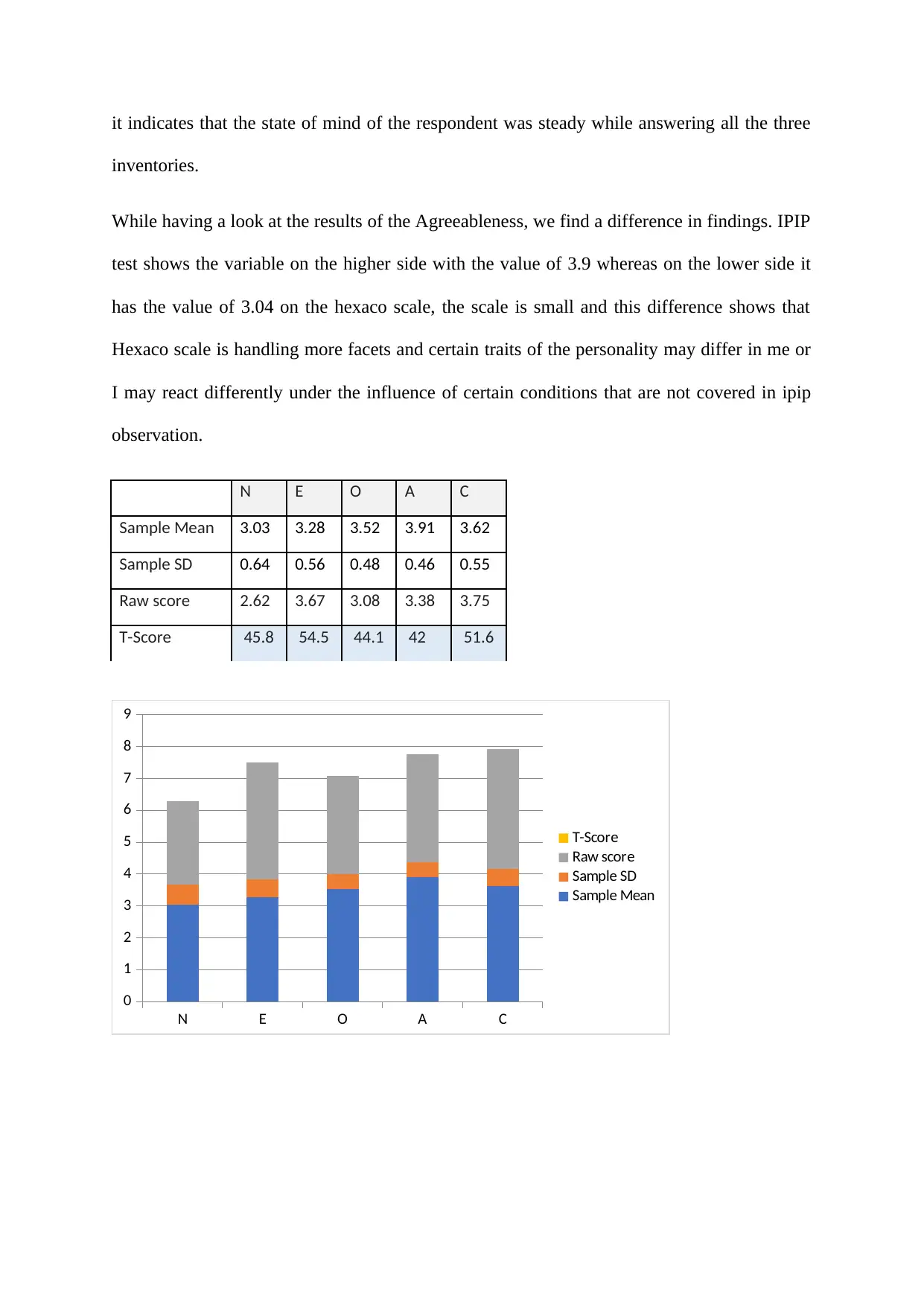
it indicates that the state of mind of the respondent was steady while answering all the three
inventories.
While having a look at the results of the Agreeableness, we find a difference in findings. IPIP
test shows the variable on the higher side with the value of 3.9 whereas on the lower side it
has the value of 3.04 on the hexaco scale, the scale is small and this difference shows that
Hexaco scale is handling more facets and certain traits of the personality may differ in me or
I may react differently under the influence of certain conditions that are not covered in ipip
observation.
N E O A C
0
1
2
3
4
5
6
7
8
9
T-Score
Raw score
Sample SD
Sample Mean
N E O A C
Sample Mean 3.03 3.28 3.52 3.91 3.62
Sample SD 0.64 0.56 0.48 0.46 0.55
Raw score 2.62 3.67 3.08 3.38 3.75
T-Score 45.8 54.5 44.1 42 51.6
inventories.
While having a look at the results of the Agreeableness, we find a difference in findings. IPIP
test shows the variable on the higher side with the value of 3.9 whereas on the lower side it
has the value of 3.04 on the hexaco scale, the scale is small and this difference shows that
Hexaco scale is handling more facets and certain traits of the personality may differ in me or
I may react differently under the influence of certain conditions that are not covered in ipip
observation.
N E O A C
0
1
2
3
4
5
6
7
8
9
T-Score
Raw score
Sample SD
Sample Mean
N E O A C
Sample Mean 3.03 3.28 3.52 3.91 3.62
Sample SD 0.64 0.56 0.48 0.46 0.55
Raw score 2.62 3.67 3.08 3.38 3.75
T-Score 45.8 54.5 44.1 42 51.6
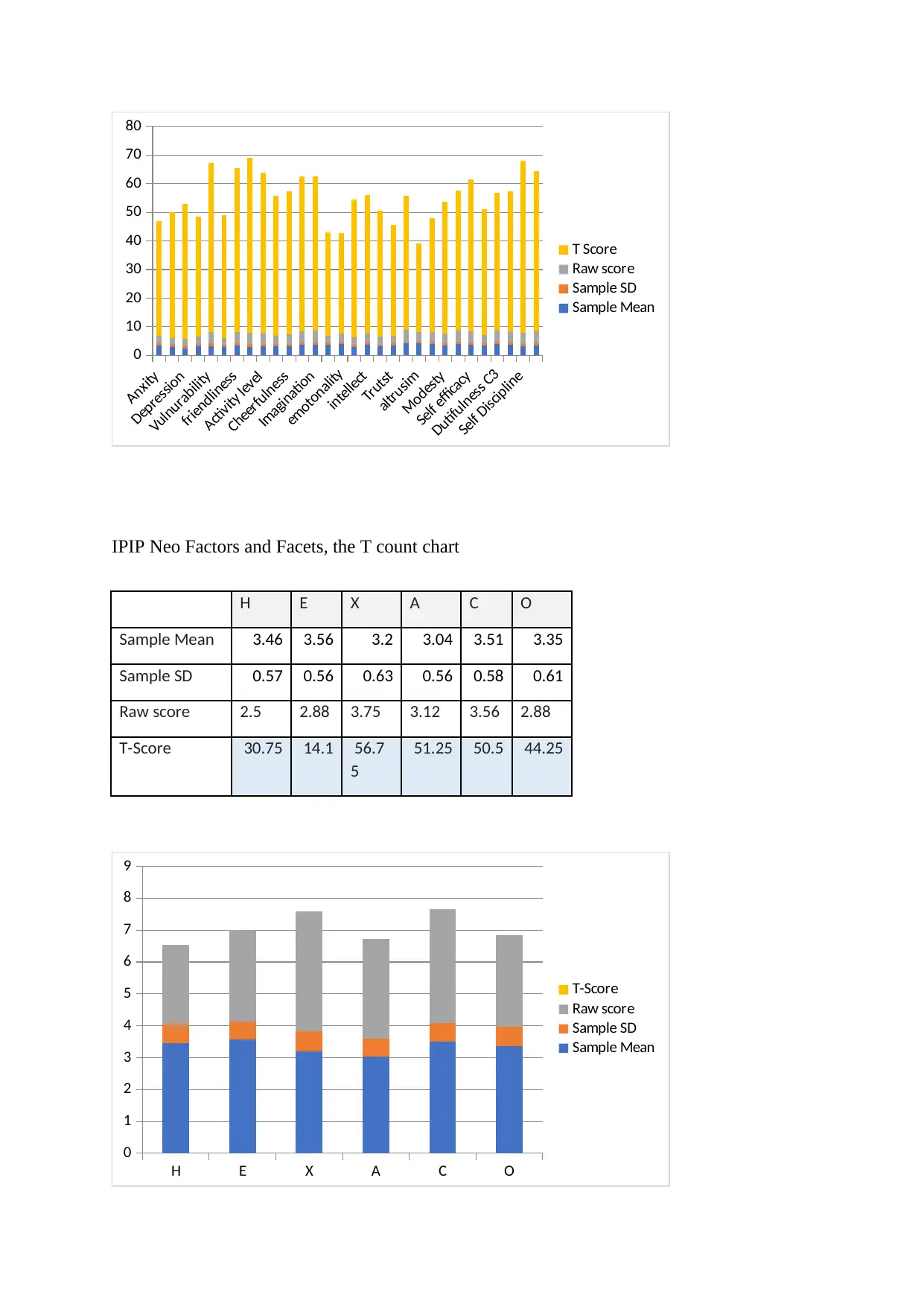
Anxity
Depression
Vulnurability
friendliness
Activity level
Cheerfulness
Imagination
emotonality
intellect
Trutst
altrusim
Modesty
Self efficacy
Dutifulness C3
Self Discipline
0
10
20
30
40
50
60
70
80
T Score
Raw score
Sample SD
Sample Mean
IPIP Neo Factors and Facets, the T count chart
H E X A C O
Sample Mean 3.46 3.56 3.2 3.04 3.51 3.35
Sample SD 0.57 0.56 0.63 0.56 0.58 0.61
Raw score 2.5 2.88 3.75 3.12 3.56 2.88
T-Score 30.75 14.1 56.7
5
51.25 50.5 44.25
H E X A C O
0
1
2
3
4
5
6
7
8
9
T-Score
Raw score
Sample SD
Sample Mean
Depression
Vulnurability
friendliness
Activity level
Cheerfulness
Imagination
emotonality
intellect
Trutst
altrusim
Modesty
Self efficacy
Dutifulness C3
Self Discipline
0
10
20
30
40
50
60
70
80
T Score
Raw score
Sample SD
Sample Mean
IPIP Neo Factors and Facets, the T count chart
H E X A C O
Sample Mean 3.46 3.56 3.2 3.04 3.51 3.35
Sample SD 0.57 0.56 0.63 0.56 0.58 0.61
Raw score 2.5 2.88 3.75 3.12 3.56 2.88
T-Score 30.75 14.1 56.7
5
51.25 50.5 44.25
H E X A C O
0
1
2
3
4
5
6
7
8
9
T-Score
Raw score
Sample SD
Sample Mean
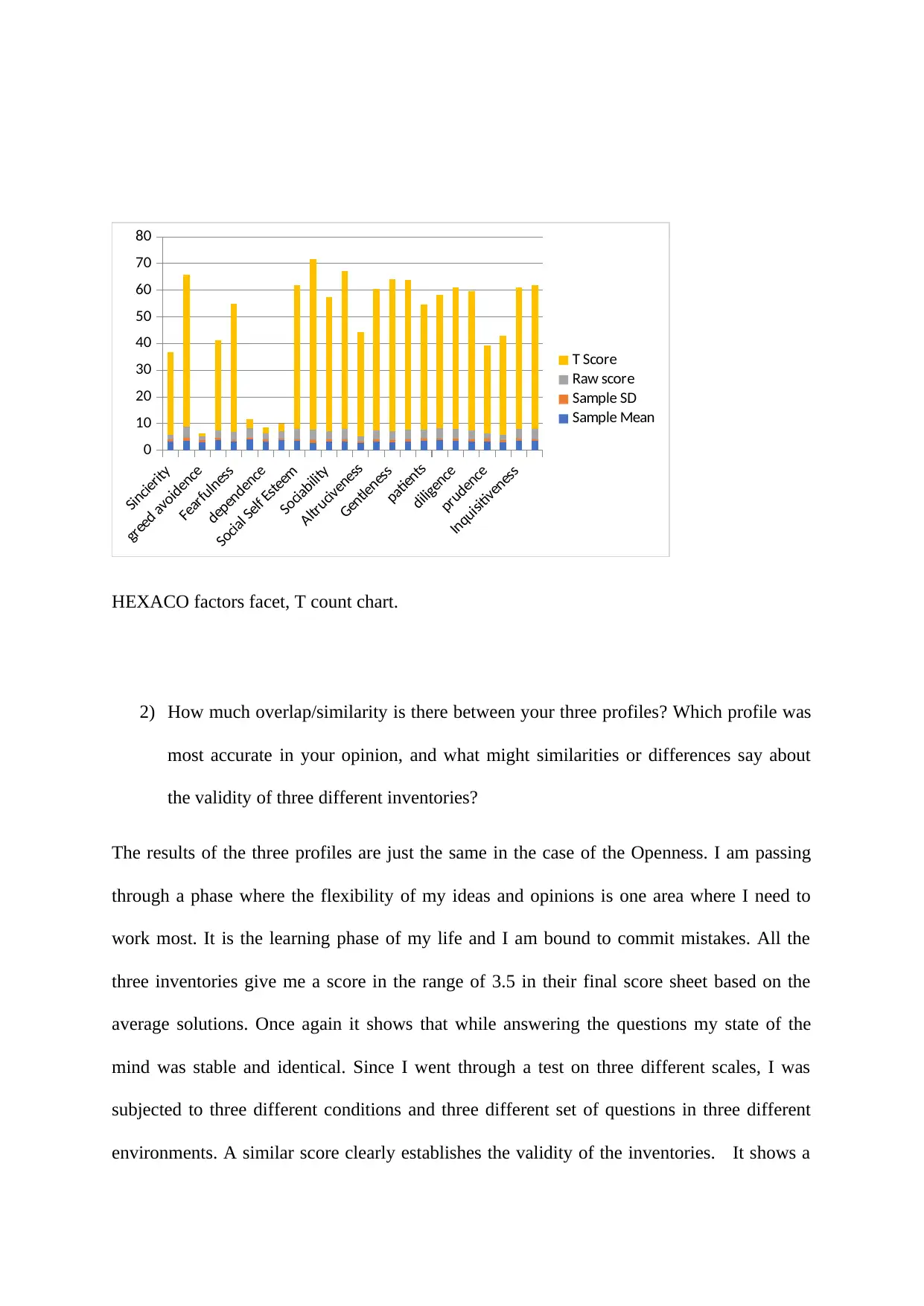
Sincierity
greed avoidence
Fearfulness
dependence
Social Self Esteem
Sociability
Altruciveness
Gentleness
patients
diligence
prudence
Inquisitiveness
0
10
20
30
40
50
60
70
80
T Score
Raw score
Sample SD
Sample Mean
HEXACO factors facet, T count chart.
2) How much overlap/similarity is there between your three profiles? Which profile was
most accurate in your opinion, and what might similarities or differences say about
the validity of three different inventories?
The results of the three profiles are just the same in the case of the Openness. I am passing
through a phase where the flexibility of my ideas and opinions is one area where I need to
work most. It is the learning phase of my life and I am bound to commit mistakes. All the
three inventories give me a score in the range of 3.5 in their final score sheet based on the
average solutions. Once again it shows that while answering the questions my state of the
mind was stable and identical. Since I went through a test on three different scales, I was
subjected to three different conditions and three different set of questions in three different
environments. A similar score clearly establishes the validity of the inventories. It shows a
greed avoidence
Fearfulness
dependence
Social Self Esteem
Sociability
Altruciveness
Gentleness
patients
diligence
prudence
Inquisitiveness
0
10
20
30
40
50
60
70
80
T Score
Raw score
Sample SD
Sample Mean
HEXACO factors facet, T count chart.
2) How much overlap/similarity is there between your three profiles? Which profile was
most accurate in your opinion, and what might similarities or differences say about
the validity of three different inventories?
The results of the three profiles are just the same in the case of the Openness. I am passing
through a phase where the flexibility of my ideas and opinions is one area where I need to
work most. It is the learning phase of my life and I am bound to commit mistakes. All the
three inventories give me a score in the range of 3.5 in their final score sheet based on the
average solutions. Once again it shows that while answering the questions my state of the
mind was stable and identical. Since I went through a test on three different scales, I was
subjected to three different conditions and three different set of questions in three different
environments. A similar score clearly establishes the validity of the inventories. It shows a
Secure Best Marks with AI Grader
Need help grading? Try our AI Grader for instant feedback on your assignments.
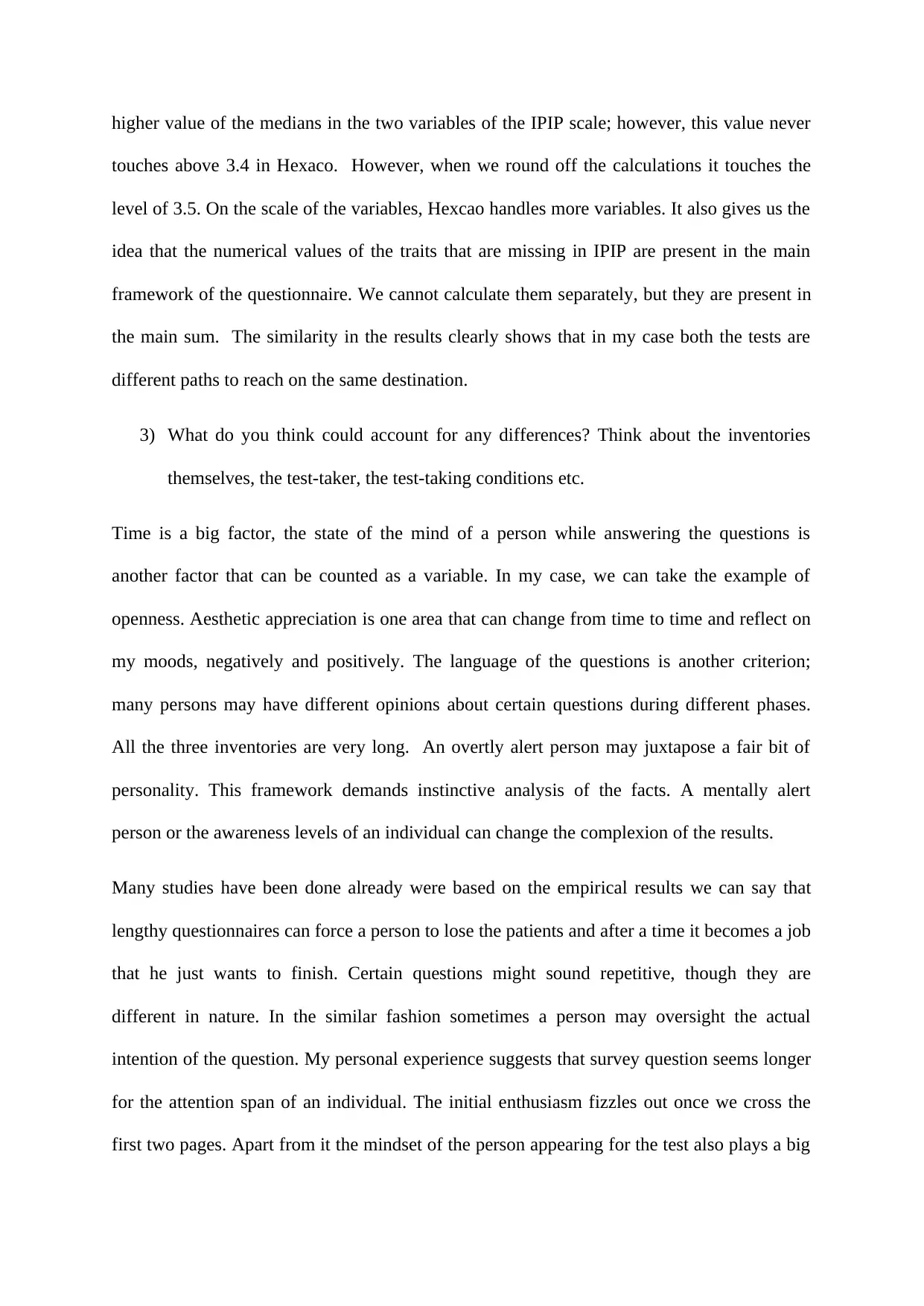
higher value of the medians in the two variables of the IPIP scale; however, this value never
touches above 3.4 in Hexaco. However, when we round off the calculations it touches the
level of 3.5. On the scale of the variables, Hexcao handles more variables. It also gives us the
idea that the numerical values of the traits that are missing in IPIP are present in the main
framework of the questionnaire. We cannot calculate them separately, but they are present in
the main sum. The similarity in the results clearly shows that in my case both the tests are
different paths to reach on the same destination.
3) What do you think could account for any differences? Think about the inventories
themselves, the test-taker, the test-taking conditions etc.
Time is a big factor, the state of the mind of a person while answering the questions is
another factor that can be counted as a variable. In my case, we can take the example of
openness. Aesthetic appreciation is one area that can change from time to time and reflect on
my moods, negatively and positively. The language of the questions is another criterion;
many persons may have different opinions about certain questions during different phases.
All the three inventories are very long. An overtly alert person may juxtapose a fair bit of
personality. This framework demands instinctive analysis of the facts. A mentally alert
person or the awareness levels of an individual can change the complexion of the results.
Many studies have been done already were based on the empirical results we can say that
lengthy questionnaires can force a person to lose the patients and after a time it becomes a job
that he just wants to finish. Certain questions might sound repetitive, though they are
different in nature. In the similar fashion sometimes a person may oversight the actual
intention of the question. My personal experience suggests that survey question seems longer
for the attention span of an individual. The initial enthusiasm fizzles out once we cross the
first two pages. Apart from it the mindset of the person appearing for the test also plays a big
touches above 3.4 in Hexaco. However, when we round off the calculations it touches the
level of 3.5. On the scale of the variables, Hexcao handles more variables. It also gives us the
idea that the numerical values of the traits that are missing in IPIP are present in the main
framework of the questionnaire. We cannot calculate them separately, but they are present in
the main sum. The similarity in the results clearly shows that in my case both the tests are
different paths to reach on the same destination.
3) What do you think could account for any differences? Think about the inventories
themselves, the test-taker, the test-taking conditions etc.
Time is a big factor, the state of the mind of a person while answering the questions is
another factor that can be counted as a variable. In my case, we can take the example of
openness. Aesthetic appreciation is one area that can change from time to time and reflect on
my moods, negatively and positively. The language of the questions is another criterion;
many persons may have different opinions about certain questions during different phases.
All the three inventories are very long. An overtly alert person may juxtapose a fair bit of
personality. This framework demands instinctive analysis of the facts. A mentally alert
person or the awareness levels of an individual can change the complexion of the results.
Many studies have been done already were based on the empirical results we can say that
lengthy questionnaires can force a person to lose the patients and after a time it becomes a job
that he just wants to finish. Certain questions might sound repetitive, though they are
different in nature. In the similar fashion sometimes a person may oversight the actual
intention of the question. My personal experience suggests that survey question seems longer
for the attention span of an individual. The initial enthusiasm fizzles out once we cross the
first two pages. Apart from it the mindset of the person appearing for the test also plays a big
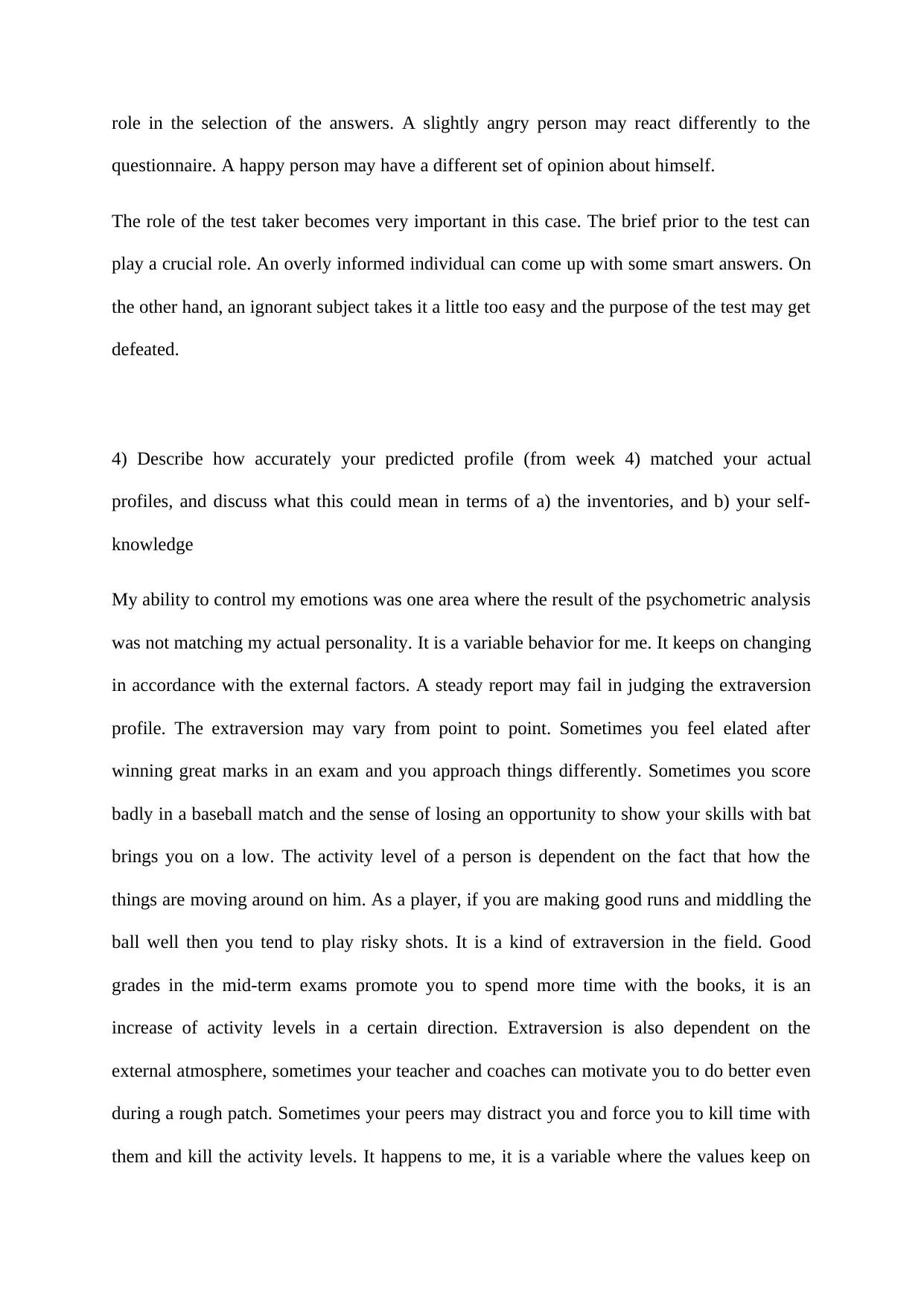
role in the selection of the answers. A slightly angry person may react differently to the
questionnaire. A happy person may have a different set of opinion about himself.
The role of the test taker becomes very important in this case. The brief prior to the test can
play a crucial role. An overly informed individual can come up with some smart answers. On
the other hand, an ignorant subject takes it a little too easy and the purpose of the test may get
defeated.
4) Describe how accurately your predicted profile (from week 4) matched your actual
profiles, and discuss what this could mean in terms of a) the inventories, and b) your self-
knowledge
My ability to control my emotions was one area where the result of the psychometric analysis
was not matching my actual personality. It is a variable behavior for me. It keeps on changing
in accordance with the external factors. A steady report may fail in judging the extraversion
profile. The extraversion may vary from point to point. Sometimes you feel elated after
winning great marks in an exam and you approach things differently. Sometimes you score
badly in a baseball match and the sense of losing an opportunity to show your skills with bat
brings you on a low. The activity level of a person is dependent on the fact that how the
things are moving around on him. As a player, if you are making good runs and middling the
ball well then you tend to play risky shots. It is a kind of extraversion in the field. Good
grades in the mid-term exams promote you to spend more time with the books, it is an
increase of activity levels in a certain direction. Extraversion is also dependent on the
external atmosphere, sometimes your teacher and coaches can motivate you to do better even
during a rough patch. Sometimes your peers may distract you and force you to kill time with
them and kill the activity levels. It happens to me, it is a variable where the values keep on
questionnaire. A happy person may have a different set of opinion about himself.
The role of the test taker becomes very important in this case. The brief prior to the test can
play a crucial role. An overly informed individual can come up with some smart answers. On
the other hand, an ignorant subject takes it a little too easy and the purpose of the test may get
defeated.
4) Describe how accurately your predicted profile (from week 4) matched your actual
profiles, and discuss what this could mean in terms of a) the inventories, and b) your self-
knowledge
My ability to control my emotions was one area where the result of the psychometric analysis
was not matching my actual personality. It is a variable behavior for me. It keeps on changing
in accordance with the external factors. A steady report may fail in judging the extraversion
profile. The extraversion may vary from point to point. Sometimes you feel elated after
winning great marks in an exam and you approach things differently. Sometimes you score
badly in a baseball match and the sense of losing an opportunity to show your skills with bat
brings you on a low. The activity level of a person is dependent on the fact that how the
things are moving around on him. As a player, if you are making good runs and middling the
ball well then you tend to play risky shots. It is a kind of extraversion in the field. Good
grades in the mid-term exams promote you to spend more time with the books, it is an
increase of activity levels in a certain direction. Extraversion is also dependent on the
external atmosphere, sometimes your teacher and coaches can motivate you to do better even
during a rough patch. Sometimes your peers may distract you and force you to kill time with
them and kill the activity levels. It happens to me, it is a variable where the values keep on
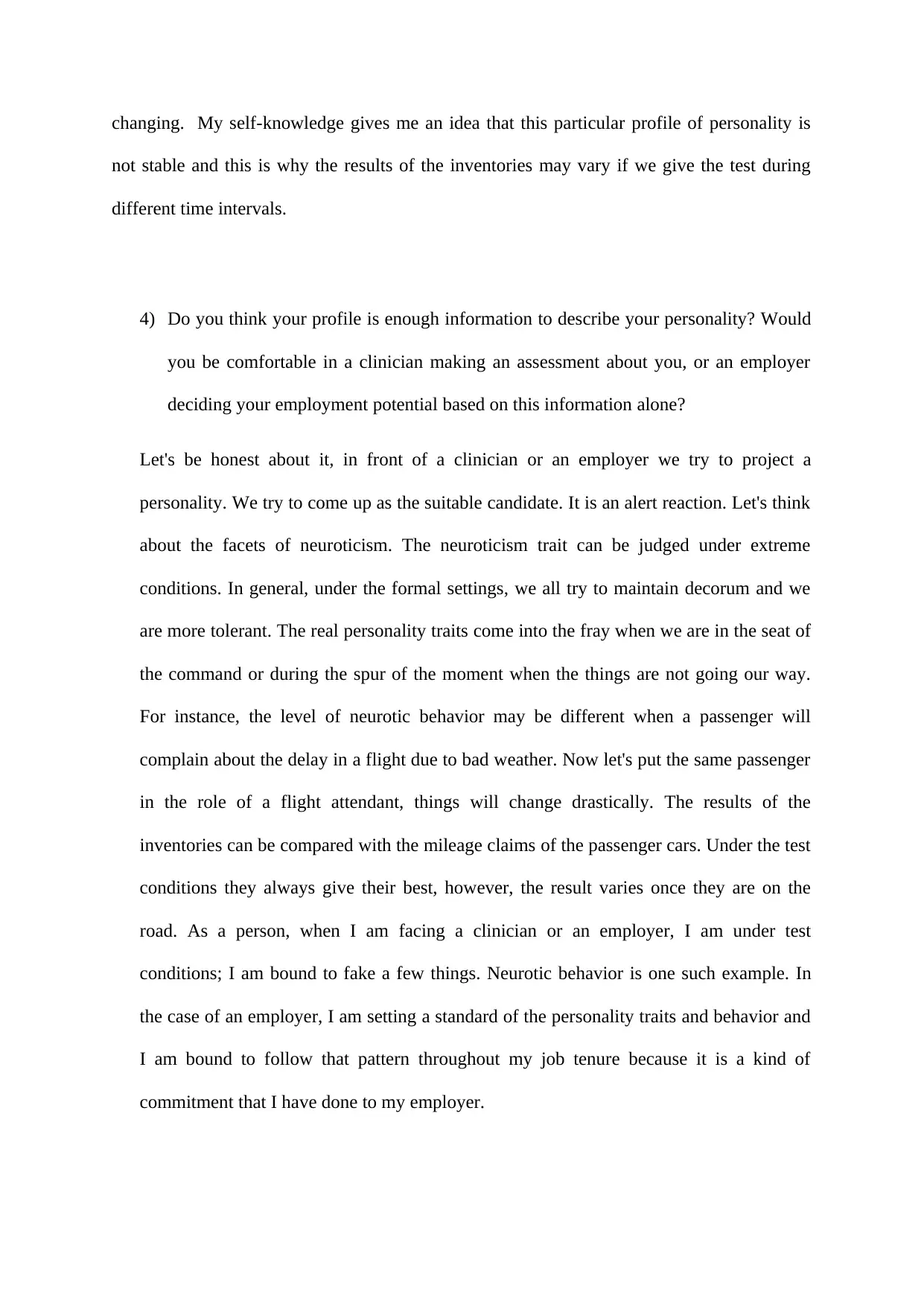
changing. My self-knowledge gives me an idea that this particular profile of personality is
not stable and this is why the results of the inventories may vary if we give the test during
different time intervals.
4) Do you think your profile is enough information to describe your personality? Would
you be comfortable in a clinician making an assessment about you, or an employer
deciding your employment potential based on this information alone?
Let's be honest about it, in front of a clinician or an employer we try to project a
personality. We try to come up as the suitable candidate. It is an alert reaction. Let's think
about the facets of neuroticism. The neuroticism trait can be judged under extreme
conditions. In general, under the formal settings, we all try to maintain decorum and we
are more tolerant. The real personality traits come into the fray when we are in the seat of
the command or during the spur of the moment when the things are not going our way.
For instance, the level of neurotic behavior may be different when a passenger will
complain about the delay in a flight due to bad weather. Now let's put the same passenger
in the role of a flight attendant, things will change drastically. The results of the
inventories can be compared with the mileage claims of the passenger cars. Under the test
conditions they always give their best, however, the result varies once they are on the
road. As a person, when I am facing a clinician or an employer, I am under test
conditions; I am bound to fake a few things. Neurotic behavior is one such example. In
the case of an employer, I am setting a standard of the personality traits and behavior and
I am bound to follow that pattern throughout my job tenure because it is a kind of
commitment that I have done to my employer.
not stable and this is why the results of the inventories may vary if we give the test during
different time intervals.
4) Do you think your profile is enough information to describe your personality? Would
you be comfortable in a clinician making an assessment about you, or an employer
deciding your employment potential based on this information alone?
Let's be honest about it, in front of a clinician or an employer we try to project a
personality. We try to come up as the suitable candidate. It is an alert reaction. Let's think
about the facets of neuroticism. The neuroticism trait can be judged under extreme
conditions. In general, under the formal settings, we all try to maintain decorum and we
are more tolerant. The real personality traits come into the fray when we are in the seat of
the command or during the spur of the moment when the things are not going our way.
For instance, the level of neurotic behavior may be different when a passenger will
complain about the delay in a flight due to bad weather. Now let's put the same passenger
in the role of a flight attendant, things will change drastically. The results of the
inventories can be compared with the mileage claims of the passenger cars. Under the test
conditions they always give their best, however, the result varies once they are on the
road. As a person, when I am facing a clinician or an employer, I am under test
conditions; I am bound to fake a few things. Neurotic behavior is one such example. In
the case of an employer, I am setting a standard of the personality traits and behavior and
I am bound to follow that pattern throughout my job tenure because it is a kind of
commitment that I have done to my employer.
Paraphrase This Document
Need a fresh take? Get an instant paraphrase of this document with our AI Paraphraser

1 out of 8
Your All-in-One AI-Powered Toolkit for Academic Success.
+13062052269
info@desklib.com
Available 24*7 on WhatsApp / Email
![[object Object]](/_next/static/media/star-bottom.7253800d.svg)
Unlock your academic potential
© 2024 | Zucol Services PVT LTD | All rights reserved.